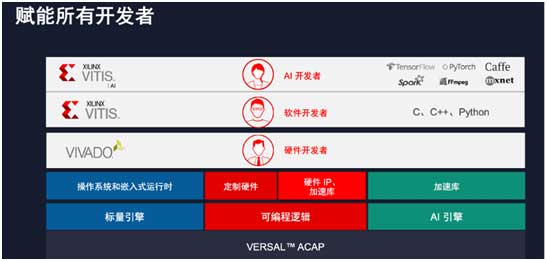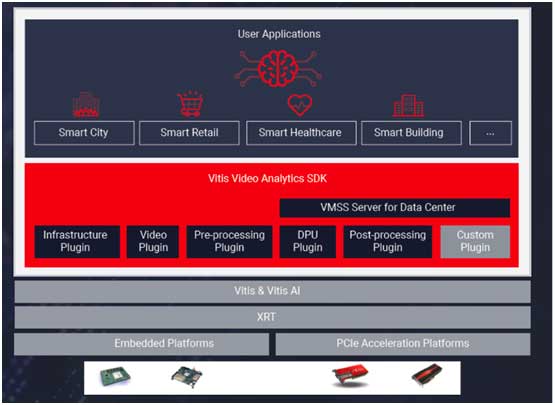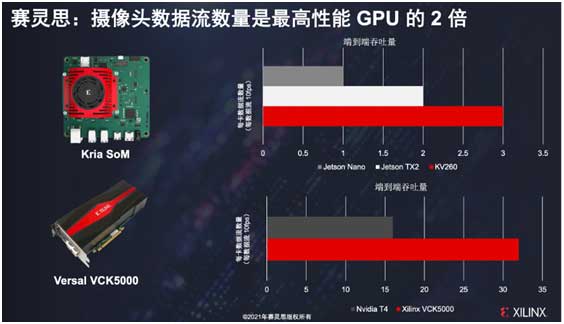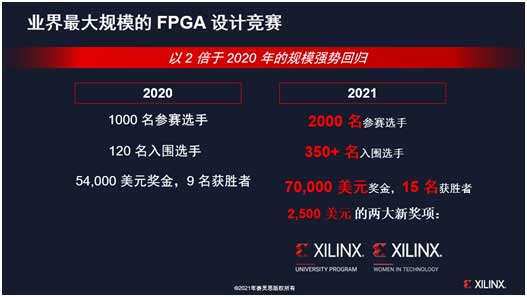
Three must-answer questions for Xilinx to make adaptive computing into mainstream processors
“What is adaptive computing? There are so many computing platforms in the industry, such as CPU, GPU, DSP, etc. Why do we need adaptive computing? What can adaptive computing bring to the industry? These questions were the most frequently asked when Xilinx launched the Adaptive Compute Acceleration Platform in 2018. After three years, what progress has Xilinx made?
“
What is adaptive computing? There are so many computing platforms in the industry, such as CPU, GPU, DSP, etc. Why do we need adaptive computing? What can adaptive computing bring to the industry? These questions were the most frequently asked when Xilinx launched the Adaptive Compute Acceleration Platform in 2018. After three years, what progress has Xilinx made?
In May of this year, Victor Peng, President and CEO of Xilinx, said in an interview with the media that in the past three years, Xilinx has been in the process of transforming from an FPGA company to an adaptive computing platform company. In spite of various external challenges, the current growth path has been maintained. Several important decisions during this period have laid a positive direction for the future. One of the major decisions includes: making the platform easier to use, making Adaptive computing empowers more innovators.
In an interview a few days ago, Andy Luo, marketing director of Xilinx’s AI and software business, further explained how to promote the popularization of adaptive computing power and how to make adaptive computing popular.

What can adaptive computing bring to the industry?
Luo Lin first pointed out the fundamental difference between adaptive computing and other computing methods – whether it is based on CPU, GPU or other computing platforms for development, software needs to be optimized to adapt to the hardware, that is, the hardware is fixed and can only be rewritten code to improve platform performance. The concept of adaptive computing is just the opposite. The platform can provide development tools, acceleration APIs, etc., can optimize hardware and define software for specific applications, and this optimization is carried out continuously, even after mass production of products, in the deployment stage. can be optimized. In short, the so-called adaptive computing is to optimize the hardware according to the specific application. The hardware is software-defined and software-programmable, which is a new generation of computing form.
As for why adaptive computing is needed? It is the technical route that Xilinx is striving to promote under the current accelerated pace of innovation. It mainly includes two aspects: one is to improve innovation efficiency, and the other is to provide ease of use for all developers.
Luo Lin said that in order to allow more developers to benefit from the high efficiency of adaptive computing platform development, Xilinx takes ease of use as an important strategic focus. By providing developers with programming languages, frameworks and integrated development environments they are familiar with, as well as sufficient accelerated API libraries and reference designs, the threshold for adaptive computing is greatly lowered, and the speed at which developers can start designing is also greatly improved.
Behind the “adaptive computing” lies Xilinx’s determination and direction from the cloud to the edge to the terminal, namely: to provide the latest architectural innovations to every part of the end-to-end application, software and AI developers only need to use the hardware abstraction tool, you can take full advantage of it without having to be a hardware expert.
How to promote the popularity of adaptive computing power?
Past development has proved that the popularity of any computing form and the popularity of any computing platform are inseparable from developers and the continuous growth of the ecosystem. To make adaptive computing popular, Xilinx needs to continue to develop the developer ecosystem to empower all developers.
Empower All Developers – This is an ambitious program that spans software and hardware developers. This means that on top of the most basic chips and components, a complete stack is required, providing a flexible hardware platform, covering different processing units, development tools, and covering adaptability and flexibility for different development environments and development groups. How does Xilinx realize this huge vision?

Luo Lin introduced that based on the Versal ACAP heterogeneous acceleration hardware platform, the upper layer covers different processing units including scalar engines, programmable logic, and AI acceleration engines, as well as hardware IP, acceleration libraries, custom hardware, and specialized AI acceleration libraries. On this basis, there are three different development tools: Vivado, which is suitable for low-level hardware IP and accelerated library development; Vitis, an integrated development environment and platform for software developers, developers can use the familiar high-level languages C, C++ and Python for programming; there is also Vitis AI, a development platform for AI reasoning, which supports AI developers to use familiar frameworks such as TensorFlow, PyTorch, and Caffe to train models, and then deploy them through Vitis AI, so that AI models can Efficiently implemented on hardware platforms.
In order to continue to unlock developer productivity, Xilinx is constantly introducing new development tools and development platforms for new applications. The machine learning-based VivadoML version was launched in June this year, and a new tool, Vitis Video Analytics SDK, for AI intelligent video analysis applications has just been released.
According to reports, the machine learning-based version of VivadoML is a breakthrough upgrade: by using machine learning technology in the Vivado environment to improve wiring delay optimization, modular automation design, thereby improving the quality of results (QoR) on average. About 10% (and even 50% higher in different tested use cases). At the same time, there is also a hierarchical compiler based on reconfigurable modules. Users can customize modules, and then perform incremental compilation and parallel compilation through Xilinx tools, thereby reducing the average compilation time by 5 times and up to 17 times.
In terms of development platform for new applications, Xilinx chose intelligent video analysis as an entry point and launched a video analysis SDK. Based on the Omdia report, Xilinx predicts that from 2020 to 2027, the compound annual growth rate of the AI inference market will be 35%, of which 55% of AI inference applications will be based on images and videos. A big reason for the SDK.

The bottom layer of the Vitis Video SDK is based on the Xilinx Alveo embedded platform, which supports runtime libraries, Vitis, Vitis AI, Gstreamer multimedia protocols, and plug-ins including video encoding and decoding, and image preprocessing. In order to build applications in smart city, smart retail, smart medical care, smart building, etc., Vitis Video SDK also provides C++ and Python interfaces, supports mainstream framework models such as TensorFlow, Pytorch, Caffe, etc., developers do not need to use RTL for programming, all Programming is based on C++ and Python API, and development efficiency can be greatly improved.

According to the evaluation data displayed, in the scenario of video decoding preprocessing and license plate recognition, Xilinx’s Kria SOM can run 3 data streams, NVIDIA Jetson Nano and TX2 can only run 1-2 channels, and Xilinx can provide about 1.5 ~3 times the performance; for Alveo accelerator cards, the main workload is running video decoding preprocessing, target detection and classification, Versal VCK5000 can achieve 32 channels, NVIDIA T4 is about 16 channels, Xilinx can provide 2 times higher throughput.
From programmable FPGAs to adaptive computing platforms, AI and machine learning have played a major role in Xilinx’s technological evolution. Luo Lin took visual analysis as an example. Traditional algorithms are more rule-based and computer vision-based. In the adaptive computing platform, Xilinx provides a flexibly configurable and scalable AI acceleration engine DPU. The platform configures and integrates the engine, and selects the size of the engine according to the chip to achieve effective AI acceleration. This is a typical presentation of the adaptive computing concept, that is, according to the application and workload, to customize the hardware and adapt the software.
How to expand ecological influence?
In order to improve developer skills and help developers design more and better projects on adaptive computing platforms, Xilinx launched a new developer program (Xilinx Developer Program) at the end of last year, which launched a new design of developers The website provides developers with Vivado, Vitis, and Vitis AI-related development resources (projects, engineering, and underlying design); the Xilinx AppStore is launched, and users can purchase Alveo cards and Kria SOM online; through the GitHub project and support the open source community to increase user awareness of Xilinx open source; added virtual training sessions, released different training videos, and created more technical e-books; launched a university program and hosted the Adaptive Computing Challenge Competition and other events; launched a developer certification program, providing early access (Early Access) opportunities for certified developers, allowing them to take the lead in accessing the latest Xilinx technologies.

It is worth mentioning that the second Adaptive Computing Challenge held this year, the scale of the competition will be twice that of last year, it is expected to attract 2000 contestants, and finally 360 finalists and 15 winners will be selected. The total prize money is $70,000. This competition also added two special awards: Xilin University Program (XUP) and Women in Technology (WIT, Women in Technology) special awards to promote the innovation of adaptive computing in colleges and universities and the diversified development of technology fields.
Luo Lin said that in terms of tool adoption, there has been a strong momentum of development. According to statistics, Vitis has been downloaded more than 150,000 times, Vitis AI has been downloaded more than 100,000 times, and more than 50% of the downloads are from new users; the developer plans to launch it for about 8 months, and has exceeded 10,000 registrations so far; The app store has been online for half a year and has covered more than 200 different applications. Xilinx hopes to continuously lower the threshold of adaptive computing, embrace all developers and data scientists, and truly make adaptive computing popular.
The Links: FF300R12KS4 6MBP100RA120 VNELECTRONIC



